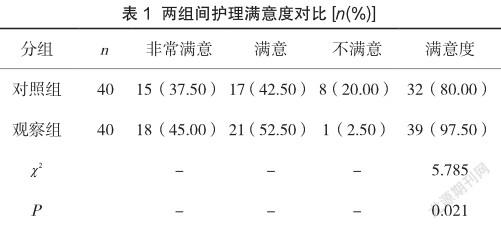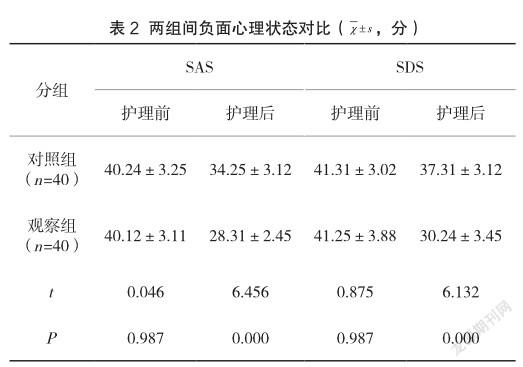無痛分娩產前尿潴留產婦個性化護理分析
張巧媛


【摘 要】目的:分析產前尿潴留行無痛分娩產婦的個性化護理方法。方法:將我院無痛分娩的產前尿潴留患者作為觀察對象,隨機數字法分為兩組,對照組采取常規護理,觀察組采取個性化護理,對比產婦護理后的滿意度、并發癥及心理狀態。結果:觀察組患者護理滿意度高于對照組(P<0.05)。觀察組患者發生產后出血1例、產后尿潴留0例;對照組患者發生產后出血3例、產后尿潴留3例;觀察組并發癥發生率為2.5%,對照組產婦并發癥發生率為15%,觀察組并發癥發生率高于對照組(P<0.05)。護理前,兩組患者SAS及SDS評分均較高(P>0.05);護理后,觀察組SAS及SDS評分均低于對照組(P<0.05)。結論:在無痛分明產前尿潴留產婦護理中,采取個性化護理有利于提升臨床護理質量。
【關鍵詞】無痛分娩;產前尿潴留;個性化護理
Personalized nursing analysis of painless childbirth
ZHANG Qiaoyuan
Fenyang hospital of Shanxi, Fenyang, Shanxi 032200, China
【Abstract】Objective: to analyze the individualized nursing methods of painless childbirth mothers with antenatal urinary retention. Methods: the patients with antenatal urinary retention in painless childbirth in our hospital were selected as the observation objects. The patients were randomly divided into two groups. The control group received routine nursing, while the observation group adopted individualized nursing. Results: the nursing satisfaction of patients in the observation group was higher than that in the control group(P<0.05). The observation group had 1 cases of postpartum hemorrhage 0 cases of postpartum urinary retention. Control group 3 cases of postpartum hemorrhage and 3 cases of postpartum urinary retention. The complication rate was 2.5% in the observation group and 15% in the control group. The complication rate in the observation group was higher than that in the control group(P<0.05). Before nursing, the SAS and SDS scores of the two groups were higher (P>0.05); After nursing, the SAS and SDS scores of the observation group were lower than those of the control group(P<0.05). Conclusion: individualized nursing is beneficial to improve the quality of clinical nursing in maternal care for painless and pre partum urinary retention.
【Key?Words】painless delivery; Prenatal urine retention ;Personalized nursing
尿潴留是圍產期常見并發癥,該疾病的發生原因較為復雜,包括產婦腹內壓增高及胎兒壓迫等[1]。一般情況下,產前尿潴留可以在產后恢復,產前往往需要導尿緩解,避免長期尿潴留對產婦的生理功能產生影響。產婦在日常生活中也要做好陰部清潔,多喝水,避免發生尿路感染。在產前尿潴留管理過程中,臨床常規護理管理模式是根據醫囑為產婦安插導尿管,對患者進行適當的指導。產前發生尿潴留的產婦容易發生負面心理,擔心分娩結局,對此,在護理過程中應當為產婦采取個性化護理干預,從而改善產婦不良心理狀態,提升臨床護理工作質量。本研究將我院納入的產婦作為觀察對象,分不同護理方法對產前尿潴留患者的影響。
1 資料與方法
1.1 一般資料
將我院2020年1月至2021年7月納入的產前尿潴留產婦80例作為觀察對象,隨機數字法對產婦進行分組,兩組產婦各40例。年齡22歲~38歲,平均年齡(30.12±4.21)歲,初產婦48例、經產婦32例,孕周36周~41周,平均孕周在(38.31±4.21)周,產婦均選擇無痛分娩,且發生產前尿潴留,兩組產婦一般資料對比(P>0.05)。
1.2 方法
對照組:產婦采取常規護理方法干預,產婦入院后,已經確診為產前尿潴留,護理人員對患者基本資料進行分析,為患者采取導尿操作,使產婦將尿液排出,在導尿后,叮囑產婦清洗陰部,預防尿路感染。

